System Analysis and Design Report: Harmony Hospital Pharmacy System
VerifiedAdded on 2022/10/09
|10
|1450
|21
Report
AI Summary
This report focuses on the design of an information system for Harmony Hospital's pharmacy to improve efficiency. It begins with an introduction outlining the project's objectives and the need for automation. Task 1 explores three investigation techniques: user observation, Joint Application Development (JAD), and prototyping, explaining their roles in gathering requirements. Task 2 then presents modeling diagrams, including a use case diagram illustrating pharmacy processes, a class diagram depicting system classes, an activity diagram showing prescription workflows, and a sequence diagram detailing doctor-pharmacy interactions. The report concludes with recommendations for system implementation, such as integrated plans and data security, and provides a bibliography of cited sources. The report aims to enhance the development process of information systems in a healthcare setting.
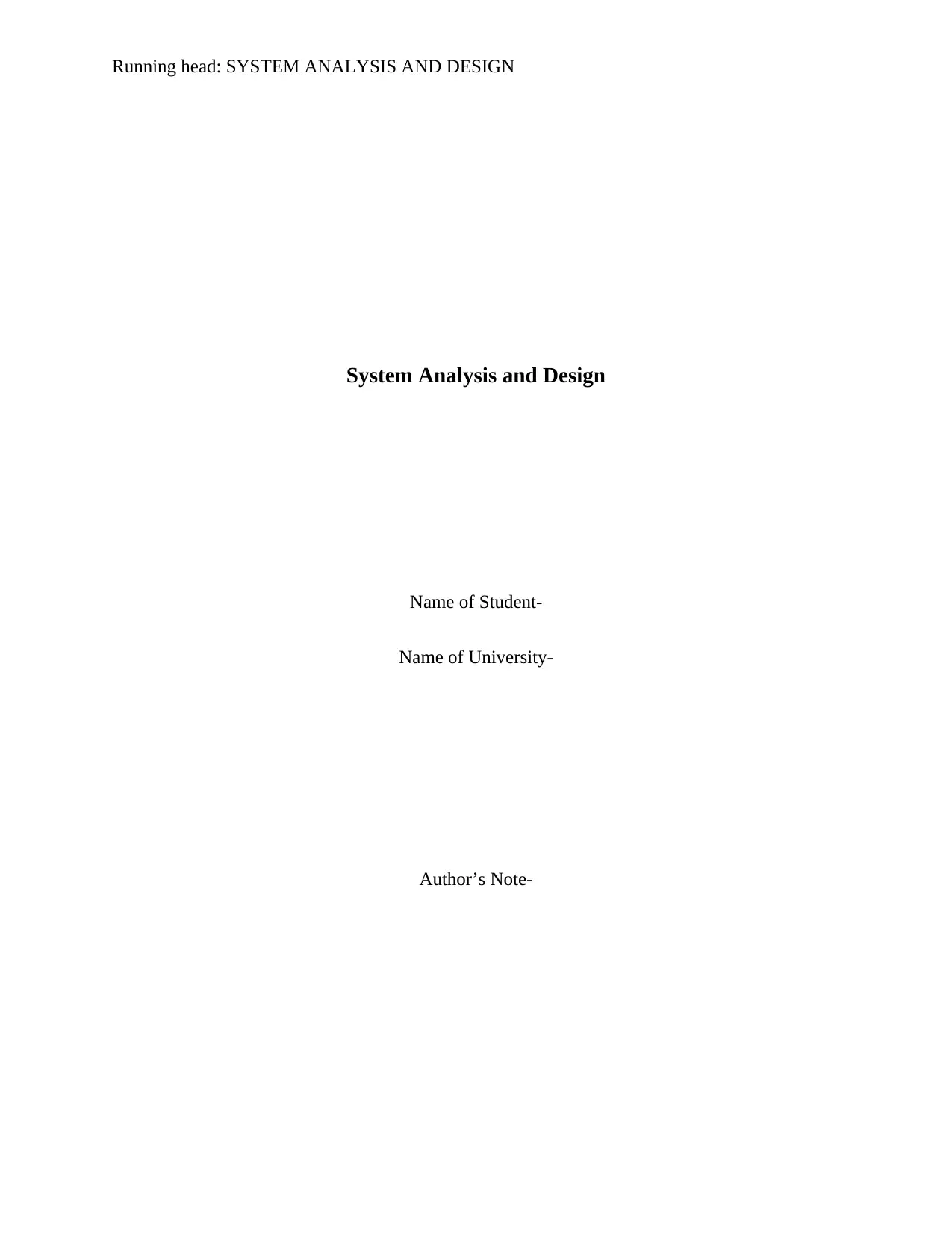
Running head: SYSTEM ANALYSIS AND DESIGN
System Analysis and Design
Name of Student-
Name of University-
Author’s Note-
System Analysis and Design
Name of Student-
Name of University-
Author’s Note-
Paraphrase This Document
Need a fresh take? Get an instant paraphrase of this document with our AI Paraphraser
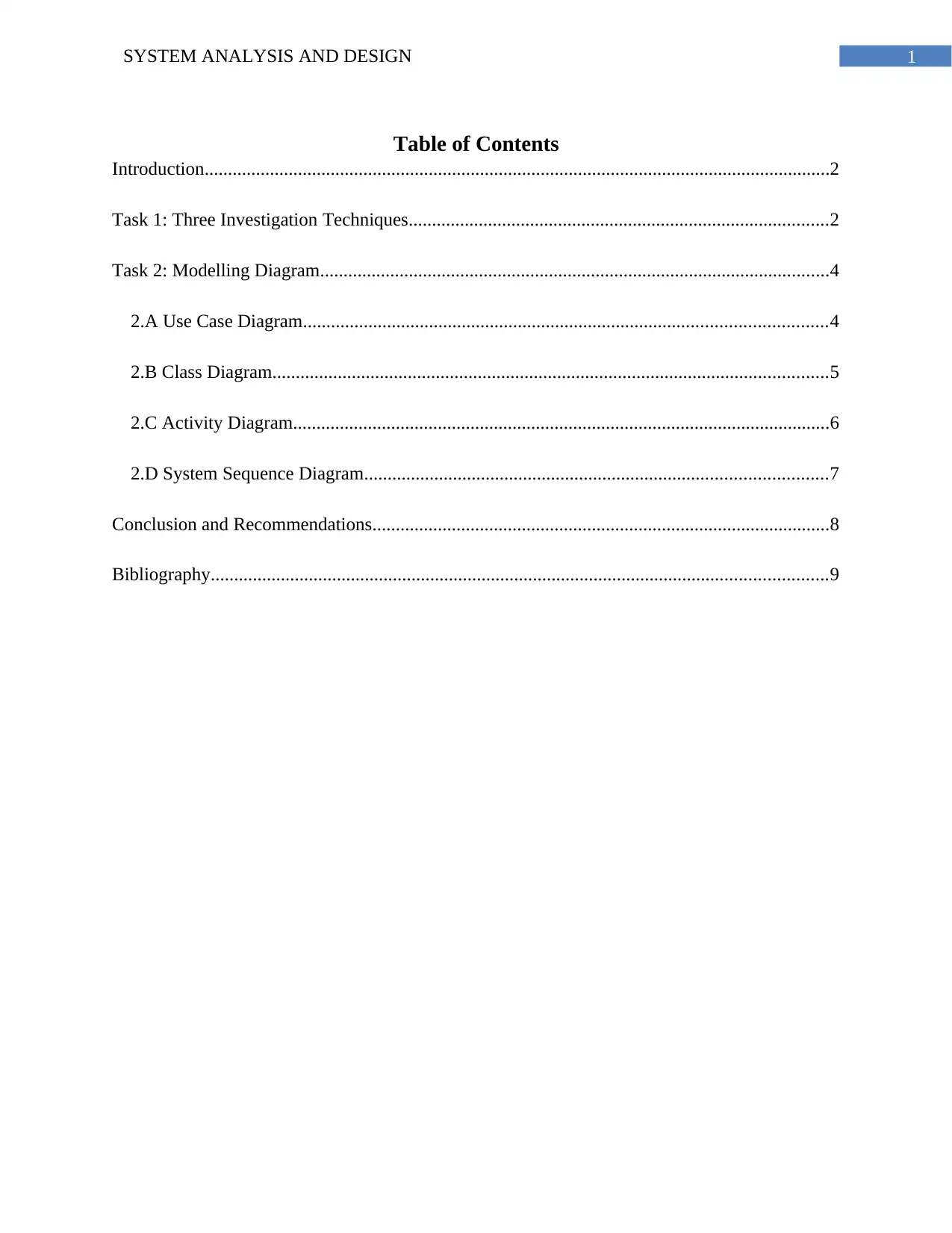
1SYSTEM ANALYSIS AND DESIGN
Table of Contents
Introduction......................................................................................................................................2
Task 1: Three Investigation Techniques..........................................................................................2
Task 2: Modelling Diagram.............................................................................................................4
2.A Use Case Diagram................................................................................................................4
2.B Class Diagram.......................................................................................................................5
2.C Activity Diagram...................................................................................................................6
2.D System Sequence Diagram...................................................................................................7
Conclusion and Recommendations..................................................................................................8
Bibliography....................................................................................................................................9
Table of Contents
Introduction......................................................................................................................................2
Task 1: Three Investigation Techniques..........................................................................................2
Task 2: Modelling Diagram.............................................................................................................4
2.A Use Case Diagram................................................................................................................4
2.B Class Diagram.......................................................................................................................5
2.C Activity Diagram...................................................................................................................6
2.D System Sequence Diagram...................................................................................................7
Conclusion and Recommendations..................................................................................................8
Bibliography....................................................................................................................................9

2SYSTEM ANALYSIS AND DESIGN
Introduction
The aim of this report is to design the pharmacy system for the Harmony hospital that
would help the pharmacists, doctors and nurses to work efficiently in the system. The objective
of this report is to design the information system and provide system design for the information
system.
The Harmony Hospital pharmacy deal with manual system of providing medicines to
their patients. This manual system should be automated by including an information system in
the pharmacy system. This system that is designed in the report would help to automate the
pharmacy system of the hospital and would make the process faster and more efficient. The
prescription provided by the doctors will be uploaded in the system and the pharmacists will get
to know if there is new requirement for the patients.
Task 1: Three Investigation Techniques
The three investigation techniques that are used for developing the information system
for pharmacy of Harmony Hospital are stated below:
a. User Observation: The user observation technique is being carried out for developing
this system. The user observation mainly helps the analyst to get an idea about how the user
interacts with the system and after improving the objective of the system helps the developer to
design the system more efficiently (Devadiga 2017). The user observation helps the developer to
clear the user requirement and implement them in the system. This technique of investigation
helps to validate the data that were collected previously in the system. The user observation
technique helps to ensure elements that are surrounds observation of the user in the system. This
Introduction
The aim of this report is to design the pharmacy system for the Harmony hospital that
would help the pharmacists, doctors and nurses to work efficiently in the system. The objective
of this report is to design the information system and provide system design for the information
system.
The Harmony Hospital pharmacy deal with manual system of providing medicines to
their patients. This manual system should be automated by including an information system in
the pharmacy system. This system that is designed in the report would help to automate the
pharmacy system of the hospital and would make the process faster and more efficient. The
prescription provided by the doctors will be uploaded in the system and the pharmacists will get
to know if there is new requirement for the patients.
Task 1: Three Investigation Techniques
The three investigation techniques that are used for developing the information system
for pharmacy of Harmony Hospital are stated below:
a. User Observation: The user observation technique is being carried out for developing
this system. The user observation mainly helps the analyst to get an idea about how the user
interacts with the system and after improving the objective of the system helps the developer to
design the system more efficiently (Devadiga 2017). The user observation helps the developer to
clear the user requirement and implement them in the system. This technique of investigation
helps to validate the data that were collected previously in the system. The user observation
technique helps to ensure elements that are surrounds observation of the user in the system. This
⊘ This is a preview!⊘
Do you want full access?
Subscribe today to unlock all pages.

Trusted by 1+ million students worldwide

3SYSTEM ANALYSIS AND DESIGN
would help the user to assist all uncertainty included in the system. The developers simply note
the requirement and implements them in the system development.
b. JAD (Joint Application Development): The main aim of this technique is designing
the system right at the first time. This reduces different iterations that takes place in the
development process of the system (Chaudhuri 2017). The managers of the organization can
provide the organizational aspect in the system. This technique helps to clarify the requirement
specification that happens in the environment.
c. Prototyping method: In prototyping method, the design of the system is done and this
technique is an iterative process that includes the user requirement completely in the system. The
prototyping method shows the user interaction process (Camburn et al., 2015). This method
includes users to be verify the requirement and helps to developer to add with other requirements
in the system. This helps to build the actual system that is being developed and all the
requirement of the users are satisfied in the system.
would help the user to assist all uncertainty included in the system. The developers simply note
the requirement and implements them in the system development.
b. JAD (Joint Application Development): The main aim of this technique is designing
the system right at the first time. This reduces different iterations that takes place in the
development process of the system (Chaudhuri 2017). The managers of the organization can
provide the organizational aspect in the system. This technique helps to clarify the requirement
specification that happens in the environment.
c. Prototyping method: In prototyping method, the design of the system is done and this
technique is an iterative process that includes the user requirement completely in the system. The
prototyping method shows the user interaction process (Camburn et al., 2015). This method
includes users to be verify the requirement and helps to developer to add with other requirements
in the system. This helps to build the actual system that is being developed and all the
requirement of the users are satisfied in the system.
Paraphrase This Document
Need a fresh take? Get an instant paraphrase of this document with our AI Paraphraser

4SYSTEM ANALYSIS AND DESIGN
Task 2: Modelling Diagram
2.A Use Case Diagram
Figure 1: Use case diagram of Harmony Hospital Pharmacy
(Source: Created by author in Visio)
Explanation: The use case above shows the pharmacy process that is carried out in the
Harmony hospital. The system has four actors in the system who are involved in the system. All
the actors have different activities that are performed in the system. All the activities that are
performed by the different actors are explained in the diagram above.
Assumptions: It is assumed that the actors will have a proper user interface to input all
the data that are related with the system. The use case is assumed as per the case study provided
and no other external information is provided in the system.
Task 2: Modelling Diagram
2.A Use Case Diagram
Figure 1: Use case diagram of Harmony Hospital Pharmacy
(Source: Created by author in Visio)
Explanation: The use case above shows the pharmacy process that is carried out in the
Harmony hospital. The system has four actors in the system who are involved in the system. All
the actors have different activities that are performed in the system. All the activities that are
performed by the different actors are explained in the diagram above.
Assumptions: It is assumed that the actors will have a proper user interface to input all
the data that are related with the system. The use case is assumed as per the case study provided
and no other external information is provided in the system.
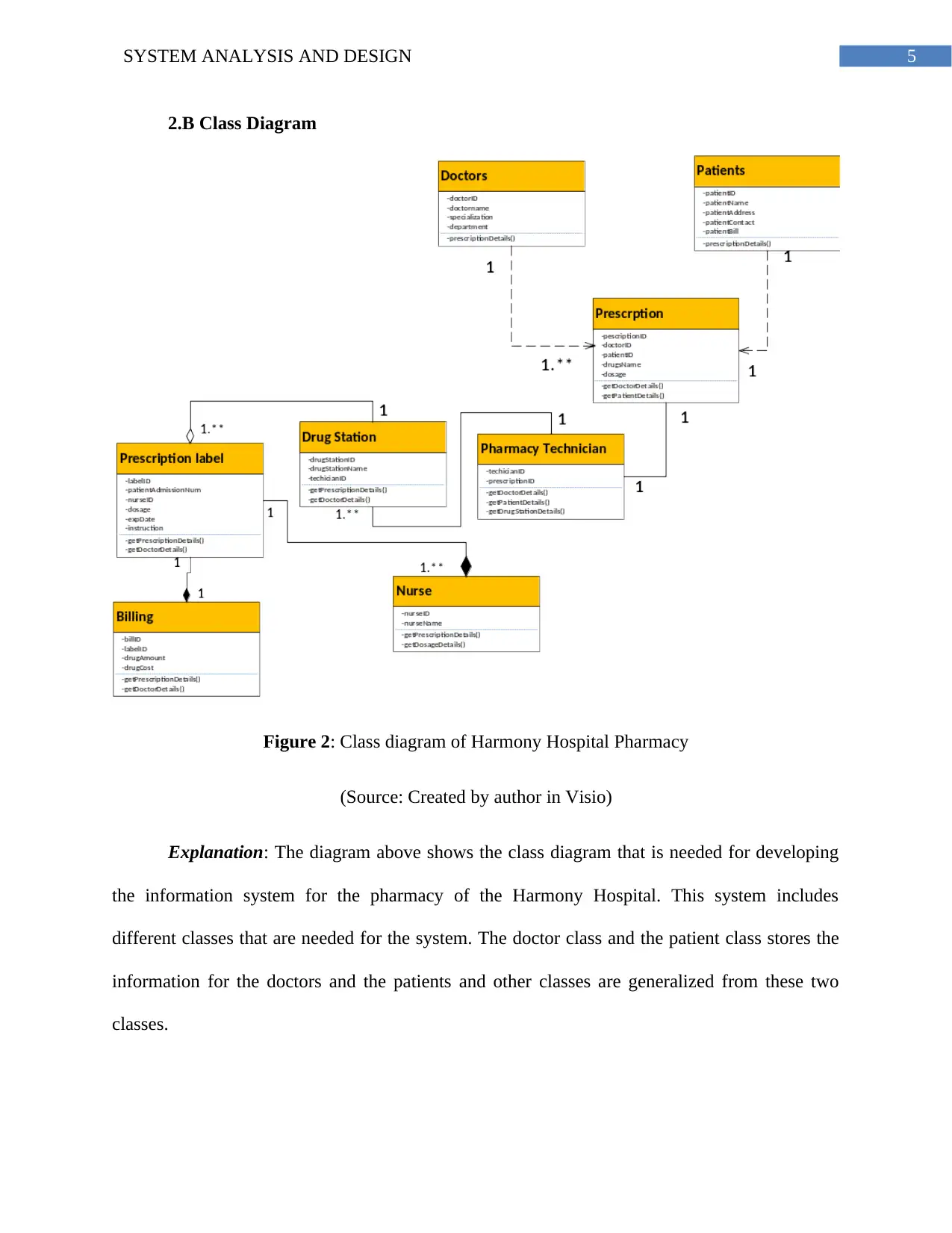
5SYSTEM ANALYSIS AND DESIGN
2.B Class Diagram
Figure 2: Class diagram of Harmony Hospital Pharmacy
(Source: Created by author in Visio)
Explanation: The diagram above shows the class diagram that is needed for developing
the information system for the pharmacy of the Harmony Hospital. This system includes
different classes that are needed for the system. The doctor class and the patient class stores the
information for the doctors and the patients and other classes are generalized from these two
classes.
2.B Class Diagram
Figure 2: Class diagram of Harmony Hospital Pharmacy
(Source: Created by author in Visio)
Explanation: The diagram above shows the class diagram that is needed for developing
the information system for the pharmacy of the Harmony Hospital. This system includes
different classes that are needed for the system. The doctor class and the patient class stores the
information for the doctors and the patients and other classes are generalized from these two
classes.
⊘ This is a preview!⊘
Do you want full access?
Subscribe today to unlock all pages.

Trusted by 1+ million students worldwide
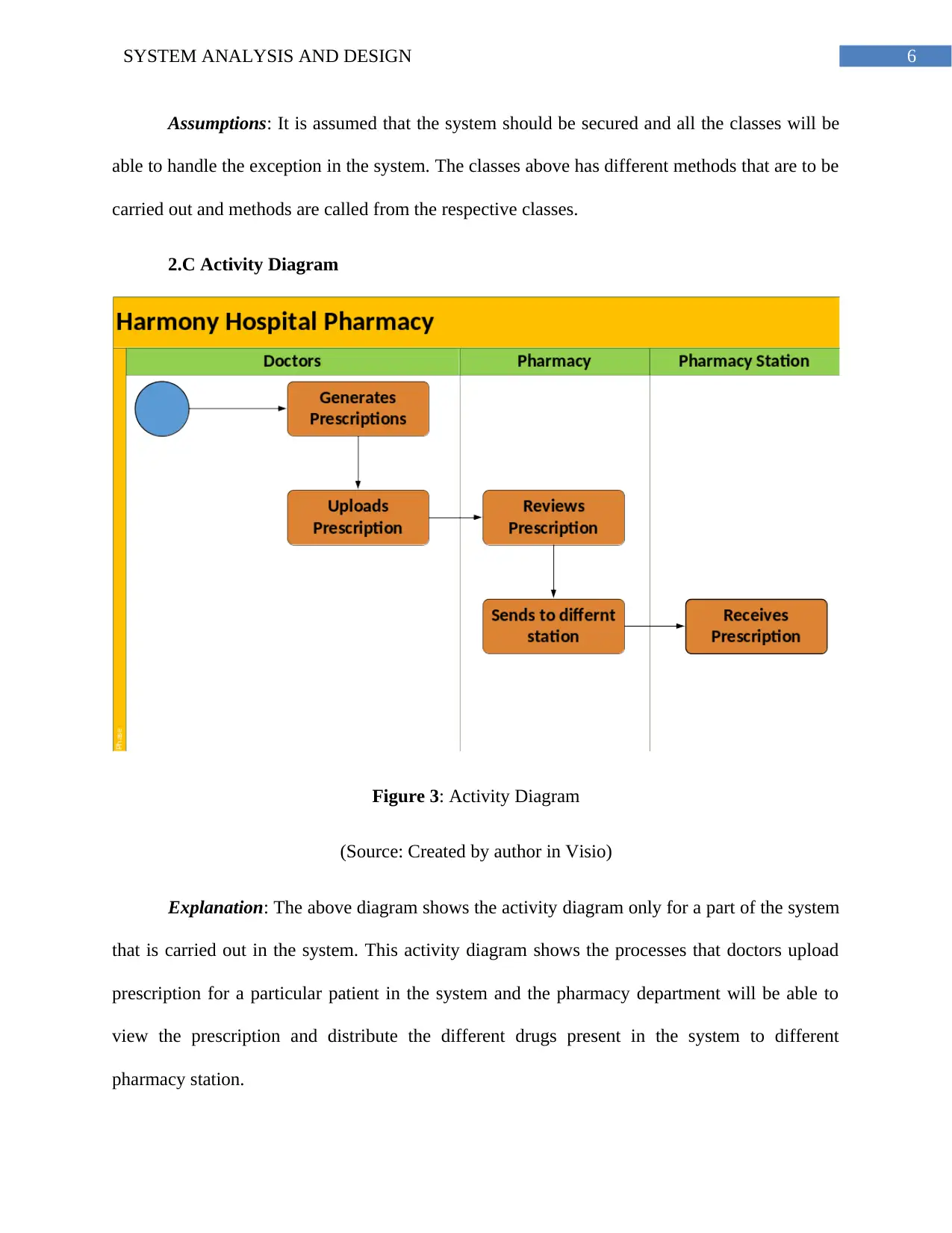
6SYSTEM ANALYSIS AND DESIGN
Assumptions: It is assumed that the system should be secured and all the classes will be
able to handle the exception in the system. The classes above has different methods that are to be
carried out and methods are called from the respective classes.
2.C Activity Diagram
Figure 3: Activity Diagram
(Source: Created by author in Visio)
Explanation: The above diagram shows the activity diagram only for a part of the system
that is carried out in the system. This activity diagram shows the processes that doctors upload
prescription for a particular patient in the system and the pharmacy department will be able to
view the prescription and distribute the different drugs present in the system to different
pharmacy station.
Assumptions: It is assumed that the system should be secured and all the classes will be
able to handle the exception in the system. The classes above has different methods that are to be
carried out and methods are called from the respective classes.
2.C Activity Diagram
Figure 3: Activity Diagram
(Source: Created by author in Visio)
Explanation: The above diagram shows the activity diagram only for a part of the system
that is carried out in the system. This activity diagram shows the processes that doctors upload
prescription for a particular patient in the system and the pharmacy department will be able to
view the prescription and distribute the different drugs present in the system to different
pharmacy station.
Paraphrase This Document
Need a fresh take? Get an instant paraphrase of this document with our AI Paraphraser
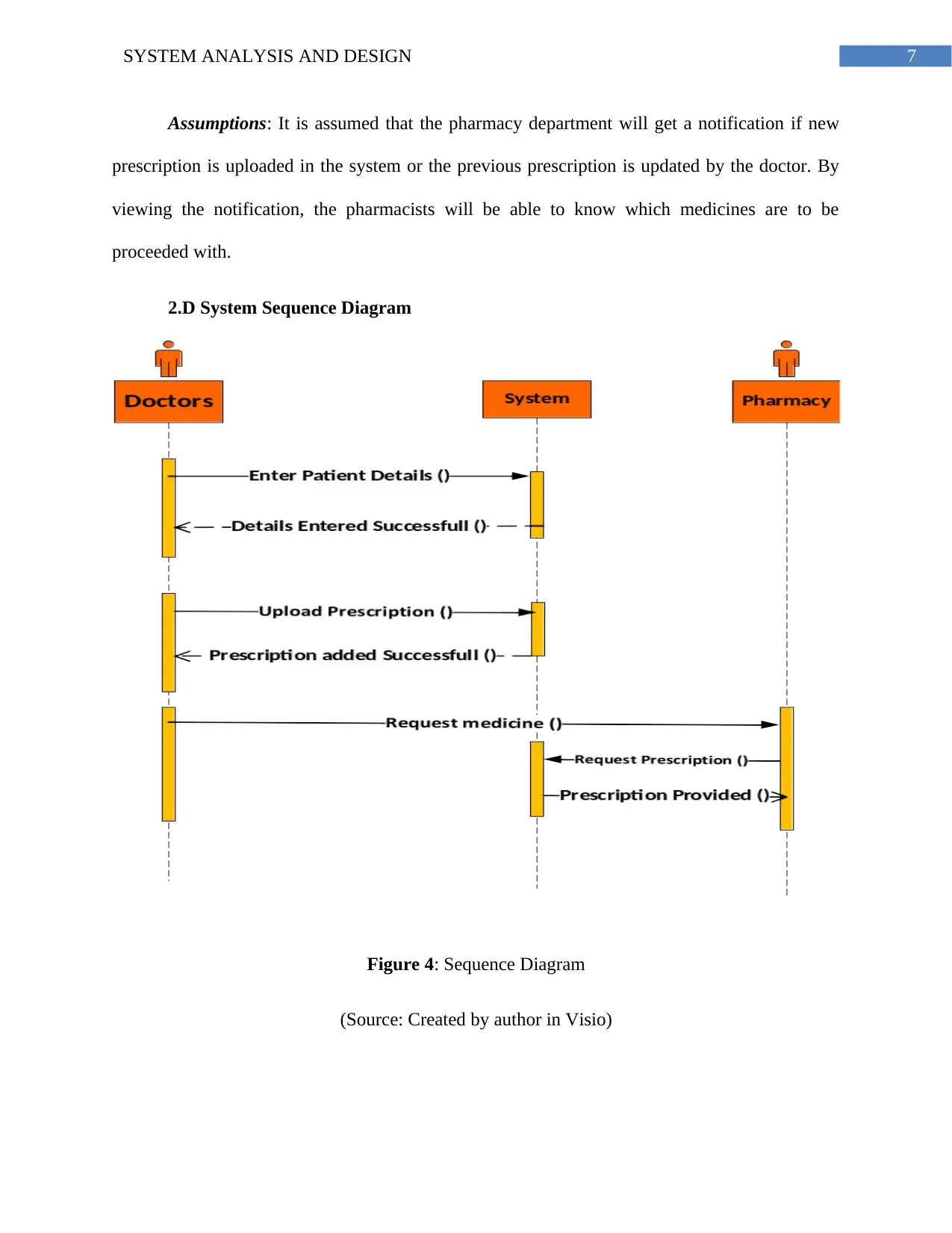
7SYSTEM ANALYSIS AND DESIGN
Assumptions: It is assumed that the pharmacy department will get a notification if new
prescription is uploaded in the system or the previous prescription is updated by the doctor. By
viewing the notification, the pharmacists will be able to know which medicines are to be
proceeded with.
2.D System Sequence Diagram
Figure 4: Sequence Diagram
(Source: Created by author in Visio)
Assumptions: It is assumed that the pharmacy department will get a notification if new
prescription is uploaded in the system or the previous prescription is updated by the doctor. By
viewing the notification, the pharmacists will be able to know which medicines are to be
proceeded with.
2.D System Sequence Diagram
Figure 4: Sequence Diagram
(Source: Created by author in Visio)
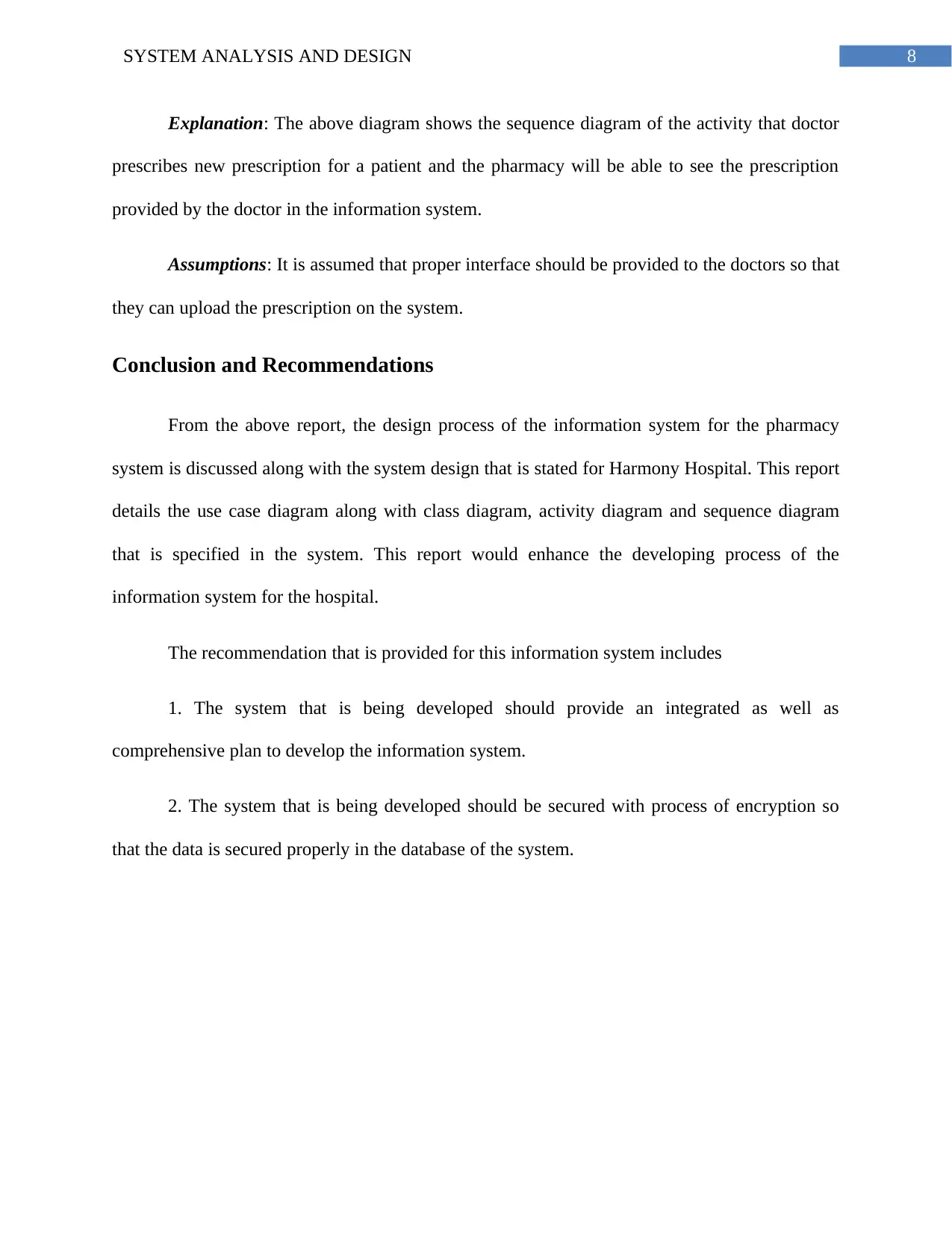
8SYSTEM ANALYSIS AND DESIGN
Explanation: The above diagram shows the sequence diagram of the activity that doctor
prescribes new prescription for a patient and the pharmacy will be able to see the prescription
provided by the doctor in the information system.
Assumptions: It is assumed that proper interface should be provided to the doctors so that
they can upload the prescription on the system.
Conclusion and Recommendations
From the above report, the design process of the information system for the pharmacy
system is discussed along with the system design that is stated for Harmony Hospital. This report
details the use case diagram along with class diagram, activity diagram and sequence diagram
that is specified in the system. This report would enhance the developing process of the
information system for the hospital.
The recommendation that is provided for this information system includes
1. The system that is being developed should provide an integrated as well as
comprehensive plan to develop the information system.
2. The system that is being developed should be secured with process of encryption so
that the data is secured properly in the database of the system.
Explanation: The above diagram shows the sequence diagram of the activity that doctor
prescribes new prescription for a patient and the pharmacy will be able to see the prescription
provided by the doctor in the information system.
Assumptions: It is assumed that proper interface should be provided to the doctors so that
they can upload the prescription on the system.
Conclusion and Recommendations
From the above report, the design process of the information system for the pharmacy
system is discussed along with the system design that is stated for Harmony Hospital. This report
details the use case diagram along with class diagram, activity diagram and sequence diagram
that is specified in the system. This report would enhance the developing process of the
information system for the hospital.
The recommendation that is provided for this information system includes
1. The system that is being developed should provide an integrated as well as
comprehensive plan to develop the information system.
2. The system that is being developed should be secured with process of encryption so
that the data is secured properly in the database of the system.
⊘ This is a preview!⊘
Do you want full access?
Subscribe today to unlock all pages.

Trusted by 1+ million students worldwide
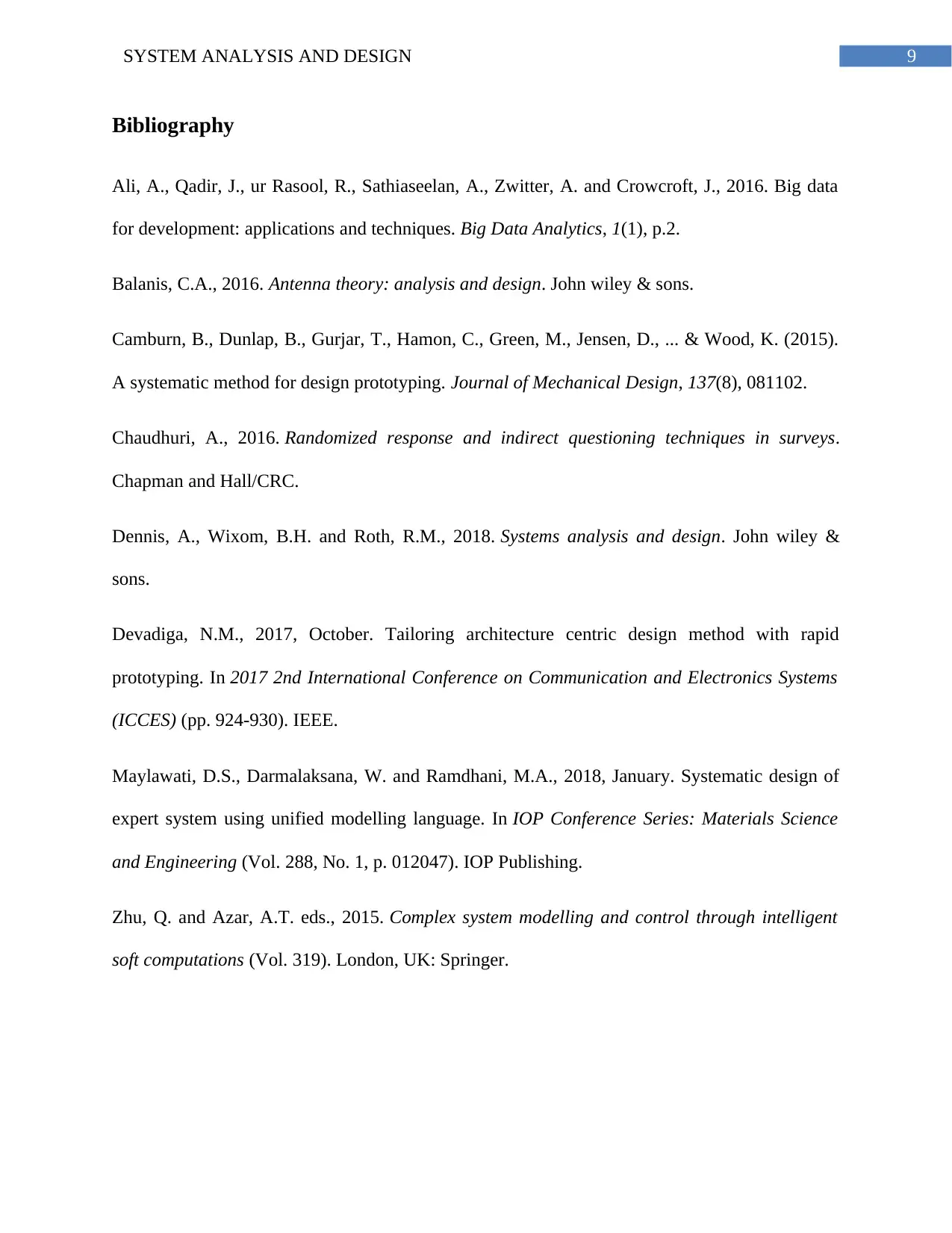
9SYSTEM ANALYSIS AND DESIGN
Bibliography
Ali, A., Qadir, J., ur Rasool, R., Sathiaseelan, A., Zwitter, A. and Crowcroft, J., 2016. Big data
for development: applications and techniques. Big Data Analytics, 1(1), p.2.
Balanis, C.A., 2016. Antenna theory: analysis and design. John wiley & sons.
Camburn, B., Dunlap, B., Gurjar, T., Hamon, C., Green, M., Jensen, D., ... & Wood, K. (2015).
A systematic method for design prototyping. Journal of Mechanical Design, 137(8), 081102.
Chaudhuri, A., 2016. Randomized response and indirect questioning techniques in surveys.
Chapman and Hall/CRC.
Dennis, A., Wixom, B.H. and Roth, R.M., 2018. Systems analysis and design. John wiley &
sons.
Devadiga, N.M., 2017, October. Tailoring architecture centric design method with rapid
prototyping. In 2017 2nd International Conference on Communication and Electronics Systems
(ICCES) (pp. 924-930). IEEE.
Maylawati, D.S., Darmalaksana, W. and Ramdhani, M.A., 2018, January. Systematic design of
expert system using unified modelling language. In IOP Conference Series: Materials Science
and Engineering (Vol. 288, No. 1, p. 012047). IOP Publishing.
Zhu, Q. and Azar, A.T. eds., 2015. Complex system modelling and control through intelligent
soft computations (Vol. 319). London, UK: Springer.
Bibliography
Ali, A., Qadir, J., ur Rasool, R., Sathiaseelan, A., Zwitter, A. and Crowcroft, J., 2016. Big data
for development: applications and techniques. Big Data Analytics, 1(1), p.2.
Balanis, C.A., 2016. Antenna theory: analysis and design. John wiley & sons.
Camburn, B., Dunlap, B., Gurjar, T., Hamon, C., Green, M., Jensen, D., ... & Wood, K. (2015).
A systematic method for design prototyping. Journal of Mechanical Design, 137(8), 081102.
Chaudhuri, A., 2016. Randomized response and indirect questioning techniques in surveys.
Chapman and Hall/CRC.
Dennis, A., Wixom, B.H. and Roth, R.M., 2018. Systems analysis and design. John wiley &
sons.
Devadiga, N.M., 2017, October. Tailoring architecture centric design method with rapid
prototyping. In 2017 2nd International Conference on Communication and Electronics Systems
(ICCES) (pp. 924-930). IEEE.
Maylawati, D.S., Darmalaksana, W. and Ramdhani, M.A., 2018, January. Systematic design of
expert system using unified modelling language. In IOP Conference Series: Materials Science
and Engineering (Vol. 288, No. 1, p. 012047). IOP Publishing.
Zhu, Q. and Azar, A.T. eds., 2015. Complex system modelling and control through intelligent
soft computations (Vol. 319). London, UK: Springer.
1 out of 10
Related Documents
Your All-in-One AI-Powered Toolkit for Academic Success.
+13062052269
info@desklib.com
Available 24*7 on WhatsApp / Email
![[object Object]](/_next/static/media/star-bottom.7253800d.svg)
Unlock your academic potential
Copyright © 2020–2025 A2Z Services. All Rights Reserved. Developed and managed by ZUCOL.





